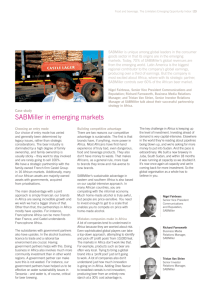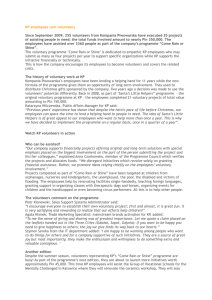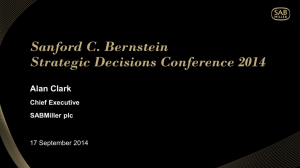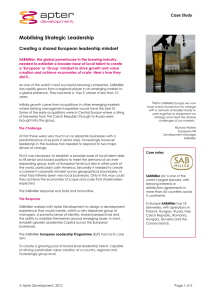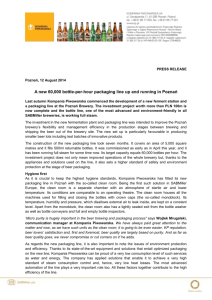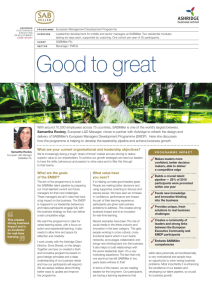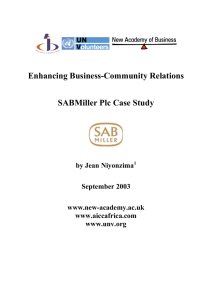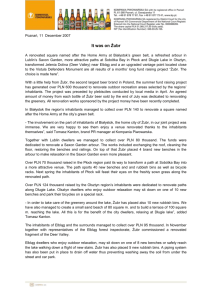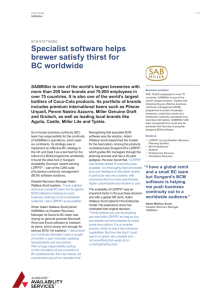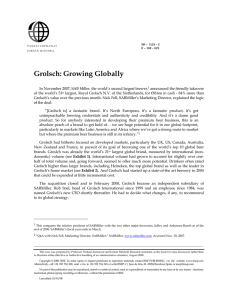Mergers & Acquisitions Analysis: SAB Miller Plc. Acquisition of Royal
advertisement
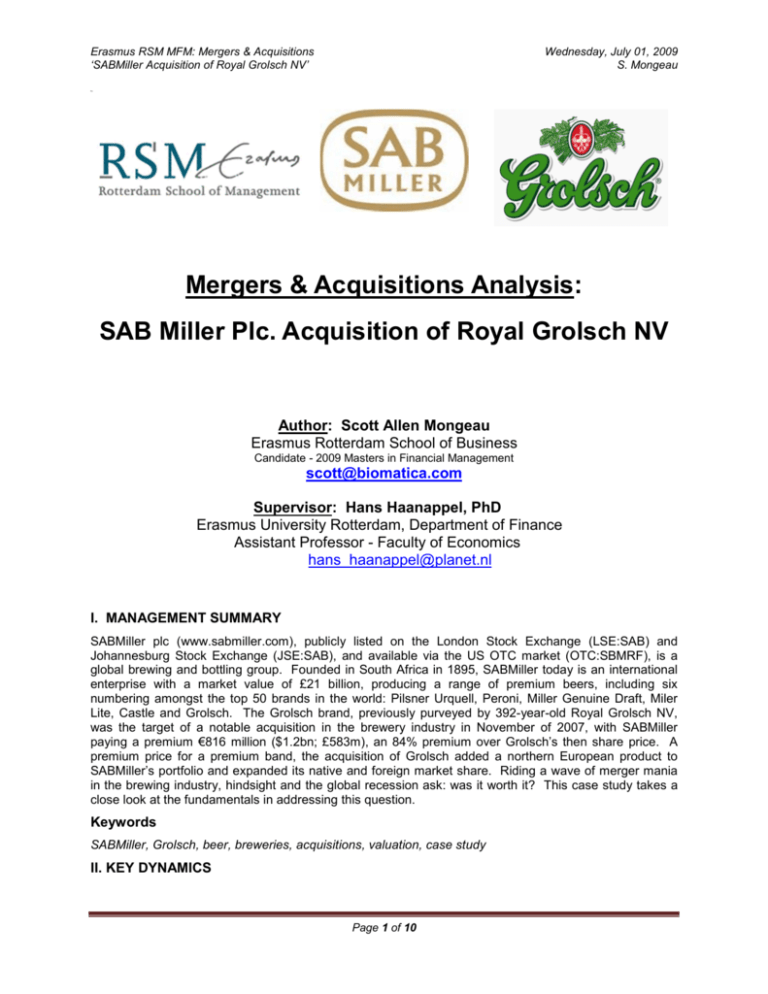
Erasmus RSM MFM: Mergers & Acquisitions ‘SABMiller Acquisition of Royal Grolsch NV’ Wednesday, July 01, 2009 S. Mongeau Dou Mergers & Acquisitions Analysis: SAB Miller Plc. Acquisition of Royal Grolsch NV Author: Scott Allen Mongeau Erasmus Rotterdam School of Business Candidate - 2009 Masters in Financial Management scott@biomatica.com Supervisor: Hans Haanappel, PhD Erasmus University Rotterdam, Department of Finance Assistant Professor - Faculty of Economics hans_haanappel@planet.nl I. MANAGEMENT SUMMARY SABMiller plc (www.sabmiller.com), publicly listed on the London Stock Exchange (LSE:SAB) and Johannesburg Stock Exchange (JSE:SAB), and available via the US OTC market (OTC:SBMRF), is a global brewing and bottling group. Founded in South Africa in 1895, SABMiller today is an international enterprise with a market value of £21 billion, producing a range of premium beers, including six numbering amongst the top 50 brands in the world: Pilsner Urquell, Peroni, Miller Genuine Draft, Miler Lite, Castle and Grolsch. The Grolsch brand, previously purveyed by 392-year-old Royal Grolsch NV, was the target of a notable acquisition in the brewery industry in November of 2007, with SABMiller paying a premium €816 million ($1.2bn; £583m), an 84% premium over Grolsch’s then share price. A premium price for a premium band, the acquisition of Grolsch added a northern European product to SABMiller’s portfolio and expanded its native and foreign market share. Riding a wave of merger mania in the brewing industry, hindsight and the global recession ask: was it worth it? This case study takes a close look at the fundamentals in addressing this question. Keywords SABMiller, Grolsch, beer, breweries, acquisitions, valuation, case study II. KEY DYNAMICS Page 1 of 10 Erasmus RSM MFM: Mergers & Acquisitions ‘SABMiller Acquisition of Royal Grolsch NV’ Wednesday, July 01, 2009 S. Mongeau A. Introduction “Grolsch will provide SABMiller with a powerful addition to its international brand portfolio. Within the SABMiller family Grolsch will continue to build on almost 400 years of brewing heritage, and together we will establish new positions in the most important emerging beer markets around the world. Both companies share a passion for the brewing tradition, and we are delighted to be part of this new chapter in Grolsch’s development.” - Graham Mackay, Chief Executive of SABMiller (SABMiller, 2007) On the cusp of SABMiller’s takeover of Royal Grolsch, CEO Mackay’s words speak to the ‘contested core’ at the heart of merger and acquisition transactions: what synergies drive this transaction and, most significantly, how much are they worth on paper? The final offer came in at €48.25 a share (SABMiller plc., 2008). Hindsight is 20/20, but it is clear today that this transaction came at the tail end of a decadeplus long bubble bull market and, specific to the brewing industry, in the closing chapter of nearly eight years of unprecedented global brewery and beer brand consolidation. Given what is known today, can it be said that this particular deal was worthwhile? Or, as some charged at the time, was the deal an expensive glass of premium beer half filled with suds? We take a close look at the fundamentals in an attempt to answer this question: did SABMiller overpay? B. Strategic Rationale The initial rationale surrounding the acquisition of Grolsch was that the deal would enhance SABMiller’s market share in premium beer markets. SABMiller’s motivation in the deal was to exploit the potential of the brand extensions in international markets, both in native, established areas (South Africa, Europe and America), as well as in burgeoning emerging markets. The company envisioned significant additional potential for the Grolsch brand across Africa and Latin America in particular, where the premium segment was and is still in its infancy. The acquisition added a business with annual sales of more than €300 million (Wilson, 2007). During November of 2007, Royal Grolsch’s company profile was characterized as such: In 2006, Grolsch reported turnover of €317.6 million and net profit of €19.2 million. Total worldwide sales volumes were 3.2 million hectoliters (hls), comprising 1.6 million hls of domestic volumes in the Netherlands, and 1.6 million of international volumes… Grolsch achieves approximately 80% of its international sales volumes in the UK, the United States, Canada, France, Australia and New Zealand through a network of alliances. (SABMiller, 2007) The SABMiller deal came on the wave of a spate of other brewing industry mergers and acquisitions, including Inbev’s historic aggressive takeover of Anheuser Bush ($46 billion initial unfriendly bid that was accepted when raised to $52 billion final bid), Carlsberg / Heineken’s takeover of Scottish Newcastle and SABMiller’s own previous acquisition of Molson Coors. SABMiller paid a premium 14.7 X 2006 reported EBITDA earnings, comparing with similar deals such as SABMiller buying Italy's Peroni in 2003 at 12.6 times, and InBev purchasing Germany's Beck's at 13 times in 2001 (Jones, 2007). In context and from their view, SABMiller’s acquisition was a sequential chess move in a high-stakes global conglomerate game of ‘expand or die’. Adding Grolsch to its portfolio in particular filled a gap in SABMiller’s brand portfolio, which lacked an established beer brand from northern Europe. Grolsch was viewed as an iconic Dutch brand whose rich Northern European heritage and premium positioning would complement and further build SABMiller’s existing international brand portfolio. Grolsch component brands like Grolsch Premium Weizen, Lemon 2.5, Grolsch Dunkel Weizen and Premium, and Premium Malt could fit and fill the current trend of consumer brand fragmentation and individuation seen in many markets. Page 2 of 10 Erasmus RSM MFM: Mergers & Acquisitions ‘SABMiller Acquisition of Royal Grolsch NV’ Wednesday, July 01, 2009 S. Mongeau Further, SABMiller’s management envisioned exploring existing and new opportunities to grow the brand as follows: In Grolsch’s existing focus markets: working with its existing partners to find opportunities to accelerate current growth trends or, if commercial and appropriate, utilizing SABMiller’s platform in some of those markets, to facilitate more growth, in line with the appropriate positioning of the brands, In markets where SABMiller has a significant infrastructure like South Africa, and countries in Latin America, Central and Eastern Europe, Africa and Asia: SABMiller would work with Grolsch to identify appropriate portfolio opportunities to introduce Grolsch as a premium North European beer, In smaller markets or markets where SABMiller or Grolsch does not have a significant distribution or production presence: SABMiller would work with Grolsch to identify opportunities to grow the brand via a portfolio approach with SABMiller’s international brands. This was viewed as moreso a revenue synergy. Other envisioned synergies included: SABMiller and Grolsch would benefit from sharing marketing and innovation skills and knowledge. SABMiller was impressed by Grolsch’s distinctive and innovative green bottles and packaging as key differentiators of the brand. In addition, the SABMiller Group expected to benefit from Grolsch’s track record for innovation and marketing, evidenced by the various advertising campaigns, new beers and state-of-the-art website. Also SABMiller had stated its commitment to people development and training and saw many opportunities for the management and staff of both Groups as a result of a combination through best practice transfer, skill development and international career enhancement. SABMiller publicized the deal mainly on expanding the brand across 60 countries and downplayed cost synergies, as per comments from Finance Director Malcom Wyman when the deal was announced (Jones, 2007). Finally, it can be noted that speculation surrounding takeover motivation in particular revolved around SABMiller losing a contract to produce Heineken, a Dutch brewing powerhouse, in its home-base market, South Africa. Taking over a storied Dutch brand thus occurs potentially as a ‘tit-for-tat’ move amongst global giants. More cynically characterized, perhaps the motivation was simply a testosterone-laced big business playground fight between South Africa, an erstwhile Dutch colony, and their long-ago colonial parents. Even if there is a grain of truth to this angle, it is worthwhile to examine the business fundamentals underlying the transaction. From examining the stated and unstated strategic motivations, we turn to the financial details. C. Bid Price Premium Based on the offer memorandum and our own calculation for the standalone value of Grolsch, the price of €48.25 per share represents a premium of, variously: 79.4%: based on the closing price as at 16 November 2007 (€26.90), the last trading day before the public announcement that conditional agreement had been reached between SABMiller and Grolsch on the Offer for Grolsch by SABMiller 84.3%: based on the average closing price over the one-month period ending 16 November 2007 (€26.17) 64.2%: based on the average closing price over the six-month period ending 16 November 2007 (€29.38) 59.0%: based on the average closing price over the twelve-month period ending 16 November 2007 (€30.34) 118.33%: based on our calculation for the standalone value of Grolsch as of 1 January 2007, assuming WACC of 10.2% and terminal growth of 2% (€22.10) Page 3 of 10 Erasmus RSM MFM: Mergers & Acquisitions ‘SABMiller Acquisition of Royal Grolsch NV’ Wednesday, July 01, 2009 S. Mongeau Over the one-month period before the announcement of the deal, the average stock prices of SABMiller and of Grolsch were £1,406.80 and €26.10 respectively. Both stocks moved approximately 5% in the opposite direction in the one-month period l the last trading day before the announcement of the deal. We can imply from the share price reaction of SABMiller and Grolsch that investors expected the transaction, which SABMiller would pay for Grolsch only at its market capitalization or around €442 million (average price of Grolsch in the one-month period before the announcement of the deal multiplies by number of shares outstanding, 16,921,507 shares). Share price of Royal Grolsch N.V. and SABMiller Plc - 15 December 2006 - March 24 2008 1600 60 SabMiller Grolsch 1400 50 40 1000 prices in Euros prices in GBp 1200 800 30 600 20 400 10 200 0 /1 12 06 20 5/ 0 1 07 20 5/ /1 7 7 7 7 7 7 00 00 00 00 00 00 /2 /2 /2 /2 /2 /2 15 15 15 15 15 15 / / / / / / 2 3 4 5 6 7 Source: Yahoo finance 8 07 20 5/ /1 9 07 20 5/ /1 /1 10 07 20 5/ /1 11 07 20 5/ /1 12 07 20 5/ 1 08 20 5/ /1 2 08 20 5/ /1 3 08 20 5/ /1 Date Figure 1: Bid Price Premium (Yahoo Finance) D. Synergies (Value Impact and Break Even Level) Underlying assumptions and results of the DCF valuation and WACC are as demonstrated in Figures 2 and 3 below, beginning with a calculation of the standalone value of Royal Grolsch NV. From the buyer’s perspective, SABMiller expects to leverage Grolsch sales growth in its established markets, Eastern and Central Europe, South Africa, and Latin America. We expect that the wider distribution channels of SABMiller will help increase the international sales revenue of Grolsch as shown in Figure 4, following. From Figure 4, we assume that only revenue synergies are created. Therefore, we assume an average EBITDA margin between year 2005 and 2006 of Grolsch at 17.6% (refer to income statement of Grolsch in G. Appendix). Note that with the stated assumptions, Grolsch would contribute around 17% of the sales 1 revenue of the premium beer segment of SABMiller . Since our assumption of the additional revenues is quite optimistic, we employ 10.2% WACC as in the calculation of the standalone value of Grolsch NV Value commercial synergies of €49.2 million is derived as a result. 1 We estimated the sales revenue of the premium beer segment for SABMiller by using the proportion between the forecasted global industry premium volumes and the total industry volumes in 2008, and then multiplied by the sales revenue of Latin America, South Africa, and 50% of sales revenue in Europe (as a proxy for sales in Eastern and Central Europe). Page 4 of 10 Erasmus RSM MFM: Mergers & Acquisitions ‘SABMiller Acquisition of Royal Grolsch NV’ Wednesday, July 01, 2009 S. Mongeau Figure 2: Financial Statement - DCF Valuation Figure 3: WACC Calculation Page 5 of 10 Erasmus RSM MFM: Mergers & Acquisitions ‘SABMiller Acquisition of Royal Grolsch NV’ Wednesday, July 01, 2009 S. Mongeau Figure 4: Financial Statement – Commercial Synergies Figure 5: WACC Effect For the WACC effect, we assume the operative capital structure of SABMiller. Also, we assume that Grolsch is treated as a big firm, thus no small firm and liquidity premiums are assumed. This results in WACC of 6.3% as shown above in Figure 5. Figure 6: Acquisition Synergy Valuation Page 6 of 10 Erasmus RSM MFM: Mergers & Acquisitions ‘SABMiller Acquisition of Royal Grolsch NV’ Wednesday, July 01, 2009 S. Mongeau As per Figure 6 above, the overall potential synergies created from the acquisition of Grolsch by SABMilller result in an end value of €797million to SABMiller as the buyer. If we assume that the market expects a bid premium of 30% over the standalone value, the breakeven EBITDA t o justify the bid premium would be €12.3 million or 21% of current EBITDA (see Figure 7 below). However, if we take the alternate premium of 118% over the standalone value (bid amount of €816 million as announced by SABMiller / calculated equity value of Grolsch €374 million), the breakeven EBITDA to justify the bid premium increases to €48.4 million or up to 83% of the current EBITDA (see Figure 8 below). Figure 7: Market Bid Premium 30% Figure 8: Alternate Bid Premium 118% Page 7 of 10 Erasmus RSM MFM: Mergers & Acquisitions ‘SABMiller Acquisition of Royal Grolsch NV’ Wednesday, July 01, 2009 S. Mongeau E. Final Assessment / Concluding Remarks The quantitative analysis undertaken suggests that SABMiller overpaid for Grolsch. Based on our value to buyer calculation of €797million, SABMiller overpaid €19 million for Grolsch (€816million accepted bid), resulting in a negative NPV for itself. In other words, SABMiller paid at EV/EBITDA of 14.1x while the implied EV/EBITDA of Grolsch was just 6.7x. Extended synergies cannot be factored in too heavily to justify the bid, as SABMiller itself downplayed synergies in publicizing the deal, remarking that the main driver was adding a brand to its portfolio and extending it in existing markets (Jones, 2007). One of the reasons attributed for the bid ‘generosity’ is that SABMiller wanted to knock-out the other potential bidder, Anheuser-Busch, in a defensive competitive move. As well, it cannot be discounted that there was not a ‘bigger bully’ motivator in confronting Netherlands-based Heineken on their home soil after they had snubbed SABMiller on an earlier, substantial South African contract brewing bid. Although the takeover offer is 84% higher than Grolsch's average share price the preceding month, SAB was able to easily finance the deal from cash flow. Analysts for Standard & Poor's commented in a note that the price was high but would not change SABMiller's debt rating (Ewing, 2007). Thus, although SABMiller overpaid, it had ancillary motivations beyond pure NPV realization. In particular, within the historical context, the major breweries were all aggressively expanding via expensive acquisitions. The brewery conglomerate acquisition mania from 2000 – 2008 was sold to investors as a ‘winner-take-all’ long-term game plan: building a massive brand portfolio supported by a global operational juggernaut and riding expanding economic growth in emerging markets (Asia and South America in particular, with Russia and Africa also being considerations). Now, however, the emerging and/or BRIC nation notion of economic decoupling has been proven a myth. The recent economic crisis has deeply and broadly affected consumer confidence and spending worldwide. Premium beer brands in particular will be hit hard. The logic of the Grolsch deal, as well as many other similar brewery industry acquisitions during the heady days of the M&A bubble are looking quite fantastical. In terms of the final assessment, much will depend on the prospects for consumer spending recovery from this point onwards. If global economies stabilize in late 2009, as many analysts anticipate, there could yet be a silver lining and logic to the notion of super-brewery conglomerates. However, if economic circumstances induce a prolonged consumer malaise, similar to 1990’s Japanese stagflation, premium brand beer conglomerates will be put under pressure to divest. The final conclusion thus defers to broad macroeconomic events now underway for the final chapter. Page 8 of 10 Erasmus RSM MFM: Mergers & Acquisitions ‘SABMiller Acquisition of Royal Grolsch NV’ Wednesday, July 01, 2009 S. Mongeau F. REFERENCES Ewing, Jack. (2007) It’s Miller Time for Grolsch, Business Week, November 19, 2007. Jones, Marc. (2007) SABMiller to Buy Grolsch for $1.2 bln, Reuters News Service, November 19, 2007. SABMiller Staff. (2007) Koninklijke Grolsch NV Supports SABMiller plc Intended Public Offer, SABMiller Press Release, SABMiller Website (www.sabmiller.com), November 19, 2007. SABMiller (2007) Annual Report 2007, SABMiller Website (www.sabmiller.com), 2007. SABMiller (2008) Annual Report 2008, SABMiller Website (www.sabmiller.com), 2008. SABMiller (2007) Our Soft Drinks Business, SABMiller Website (www.sabmiller.com), December 2007. SABMiller plc. (2008) Recommended Cash Offer by SABMiller, Offer Memorandum, SABMiller Website (www.sabmiller.com), January 7, 2008. Wilson, Amy. (2007) SABMiller Will Purchase Grolsch for EU816 Million, Bloomberg News Service, Bloomberg website (www.bloomberg.com ), November 19, 2007. Page 9 of 10 Erasmus RSM MFM: Mergers & Acquisitions ‘SABMiller Acquisition of Royal Grolsch NV’ Wednesday, July 01, 2009 S. Mongeau G. APPENDIX Grolsch Balance Sheet and Income Statement (2005 – 7) Page 10 of 10
